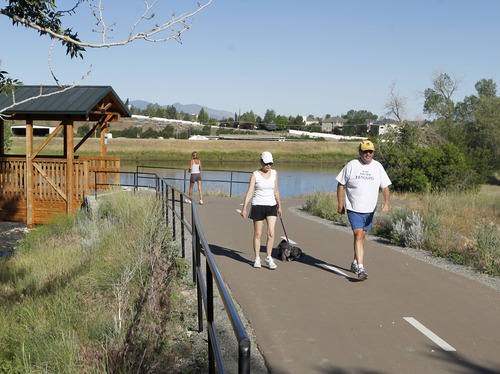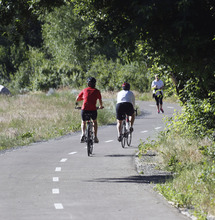This is an archived article that was published on sltrib.com in 2013, and information in the article may be outdated. It is provided only for personal research purposes and may not be reprinted.
Big Cottonwood Trail, constructed in phases over several years, is virtually complete.
Workers will be wrapping a few odds and ends for a while, but the last segment — a 1,600-foot asphalt path that climbs a steep slope, explores the underside of Wasatch Boulevard and ends at the park-and-ride lot inside Big Cottonwood Canyon — is open to the public. Only a small piece of the trail remains to be built if the city of Cottonwood Heights can win easements from two property owners. Otherwise, it's done.
To mark the end of the latest construction phase and the official opening of the segment, a ribbon-cutting ceremony will be held soon, said Cottonwood Heights Mayor Kelvyn Cullimore.
Roughly 1.5 miles long from end to end, the full trail is a 10-foot-wide asphalt path that begins at I-215 near the Cottonwood Corporate Center and runs to Big Cottonwood Canyon's mouth at the intersection of Wasatch and Fort Union boulevards.
As it gradually rises toward the canyon, the trail crosses 3000 East, jogs past a small reservoir used for flood control and parallels a stretch of Big Cottonwood Creek in Old Mill Park until it bumps into Big Cottonwood Canyon Road at the old Deseret paper mill. At that point, the trail turns gently uphill to follow the road a few hundred yards, then ends at the driveway of a private residence where a pair of horses are penned inside a corral.
Just past the residence and an adjoining road is where the newest section of the trail resumes. It runs through one of the most pristine properties in Salt Lake Valley, a leafy tract owned by the city of Murray, which gets 20 percent of its drinking water from several wells sunk into the ground.
The section is little more than a quarter-mile, but at $1.2 million, it was the most expensive to build, Cullimore said. The trail runs steeply uphill, then slips under the four traffic lanes of Wasatch Boulevard. At the far end, a set of steps ascends to the park-and-ride lot, which means pedestrians can avoid crossing the crowded Wasatch-Fort Union intersection. Within 12 months, the city will build a bicycle ramp.
"I think it will create a tremendous opportunity for improving safety at that intersection," the mayor said.
Most of the cost of the latest construction was paid with a federal grant. The city put up about $300,000. The entire trail probably cost $2 million to $2.5 million to build. Cullimore said financing came from a variety of sources, such as the state Legislature, the Zoo Arts and Parks fund, federal Transportation Enhancement funds and city appropriations.
Other than the bicycle ramp, all that remains to do is some landscaping and installing railings along the trail.
"It's a great way to develop the natural beauty of our city and allow people the opportunity to enjoy it on foot or on bike," Cullimore said. "I think it's going to be a great amenity."
Twitter: @sltribpaul









